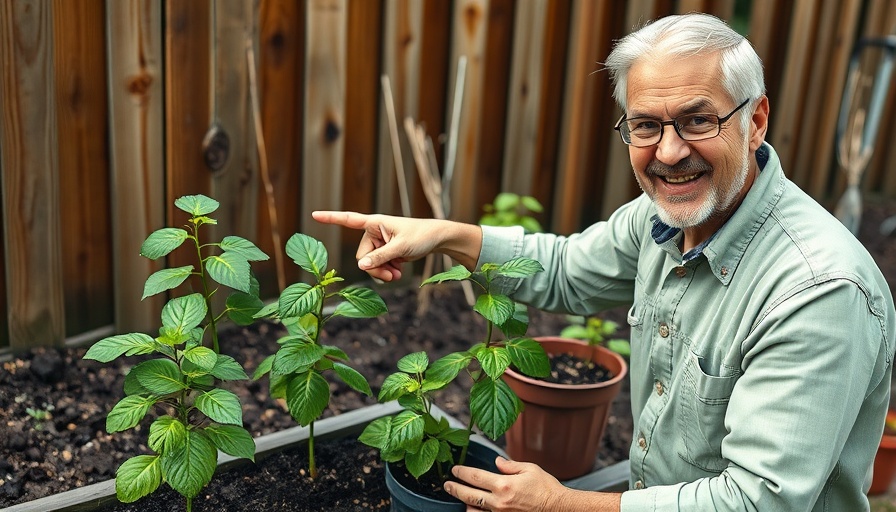
Unlocking the Secrets of Successful Transplanting
For Okanagan gardeners looking to elevate their planting skills, understanding the soil and the science behind transplanting can significantly impact your gardening success. The master class highlighted in the video titled "You’re Planting Wrong — A Soil Scientist’s Outdoor Masterclass & Why it works" provides valuable insights into the world of transplanting, emphasizing the importance of details often overlooked by casual gardeners.
In 'You’re Planting Wrong — A Soil Scientist’s Outdoor Masterclass & Why it works', the focus is placed on the science of transplanting, which we are expanding on in this article.
Why Depth Matters: The Science Behind Planting
One of the primary lessons shared is the significance of planting depth. For instance, tomatoes can be sunk up to the fifth leaf, while peppers should remain flush with the soil surface. This intricacy stems from how plants respond to their environments. When buried too deep, peppers experience stress and may fail to root adequately, as their physiological makeup doesn’t replicate the same adventitious roots seen in tomatoes. Understanding these nuances allows gardeners to cater to the specific needs of each plant.
A Closer Look at Soil Conditions
The quality of soil significantly affects plant health. Before planting, it is crucial to prepare the planting hole properly. Soil should not appear shiny or glazed—this can lead to poor drainage. By roughing up the edges and incorporating organic material such as compost, gardeners can enhance soil drainage and nutrient availability. Remember, the ideal planting hole should be three times larger than the root ball, maximizing the chance for roots to spread freely and absorb nutrients.
Cultivating a Protective Environment: Hardening Off
Moreover, the importance of hardening off plants cannot be overstated. Incorporating simple techniques like the "bucket trick"—placing a bucket over your seedlings to shade and buffer against wind—can greatly benefit your plants. Allowing them gradual exposure to outdoor conditions increases their resilience and promotes healthy growth in their new environment.
Understanding Temperature Variability
Temperature fluctuations play a pivotal role in gardening success. Raised beds can significantly warm up compared to conventional gardens, and the planting depth affects the temperature experienced by roots. Too deep, and you may chill your plants, while planting too shallow could expose them to excessive heat. Assessing soil temperature holistically, including testing during different times of day, can yield fruitful insights for optimal planting practices.
The Fertilizer Dilemma: Timing and Placement
A key takeaway from the master class is the placement of fertilizers. These nutrients should ideally be placed beneath the root ball to avoid root burn while ensuring accessibility for root growth. Alternatively, a top dressing can help with moisture retention and nutrient supply without the risk of immediate leaching or burn. The specifics of fertilizer application can markedly improve plant health and productivity.
Microclimates: Gardening in Different Environments
Okanagan's diverse climates mean that your local environment might present unique challenges or advantages. The instructor encourages gardeners to become their own scientists, experimenting with different methods suited to their specific microclimates. This adaptability is crucial—what works well for one gardener in the same region may not apply universally.
Embracing the Gardening Community
Engaging with fellow gardeners can provide invaluable insights as well. The video discusses the supportive community within the gardening niche. Sharing experiences can foster learning and improve overall gardening techniques. Whether you’re a beginner or a seasoned expert, exchanging knowledge with locals can propel your garden forward.
In closing, the practical insights from the soil scientist's master class serve as an essential guide for Okanagan gardeners. By implementing these strategies, not only can you increase the chances of thriving plants, but you can also cultivate a deeper appreciation for the science behind gardening. So go ahead—soil test, experiment, and prepare those beds—and watch your garden flourish!
Curious about more tips? Dive into these gardening methods, experiment with different plants, and step up your gardening game. Your backyard oasis awaits!
 Add Row
Add Row  Add
Add 




Write A Comment